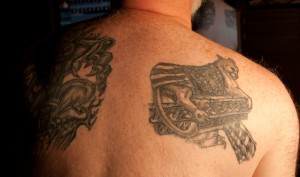 I spent a long time thinking up what sort of tattoos I’d like to have on my body. Each one has meaning to me, even if they might not to another person. They reflect an aspect of my life and my internal vision of myself, my goals, and my philosophies.The first one is this cougar here, resting on a building ledge, wrapped in the American flag. It came from the cover of a trade paperback, The Puma Blues. I had this one done in 1992, shortly after the city council repealed a law banning tattoo parlors in Athens. It’s on my right shoulder. I get a lot of people asking me why it isn’t in color; the simple explanation is that the original artwork was black and white. I think the black and white shading suits the tone of the piece. The artist used a water shading technique that he was experimenting with to provide better gray shading. Unfortunately, a lot of the ink washed out as a result, and I had it re-touched in 2011. This piece was finished in two sessions; one lasting 3 hours, the other lasting 2 hours.
I spent a long time thinking up what sort of tattoos I’d like to have on my body. Each one has meaning to me, even if they might not to another person. They reflect an aspect of my life and my internal vision of myself, my goals, and my philosophies.The first one is this cougar here, resting on a building ledge, wrapped in the American flag. It came from the cover of a trade paperback, The Puma Blues. I had this one done in 1992, shortly after the city council repealed a law banning tattoo parlors in Athens. It’s on my right shoulder. I get a lot of people asking me why it isn’t in color; the simple explanation is that the original artwork was black and white. I think the black and white shading suits the tone of the piece. The artist used a water shading technique that he was experimenting with to provide better gray shading. Unfortunately, a lot of the ink washed out as a result, and I had it re-touched in 2011. This piece was finished in two sessions; one lasting 3 hours, the other lasting 2 hours.
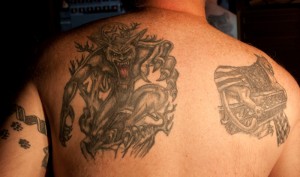 This one is on my left shoulder. I had it done in 1994, by the same artist. I gave him a general idea, and let him run with it. We went through several rough sketches before refining this one. This time, he stuck to tried and true shading techniques, and the ink has held up better. I had it re-touched as well in 2011. This one took three sessions; one 3 hour, one 2 hour, and a final 3 hour. I found the fleshy area between the shoulderblade and the spine to be the most painful spot. Yes, tattoos do hurt.
This one is on my left shoulder. I had it done in 1994, by the same artist. I gave him a general idea, and let him run with it. We went through several rough sketches before refining this one. This time, he stuck to tried and true shading techniques, and the ink has held up better. I had it re-touched as well in 2011. This one took three sessions; one 3 hour, one 2 hour, and a final 3 hour. I found the fleshy area between the shoulderblade and the spine to be the most painful spot. Yes, tattoos do hurt.

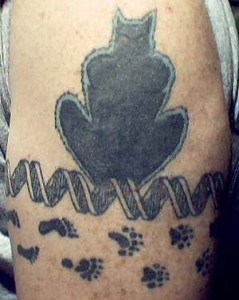
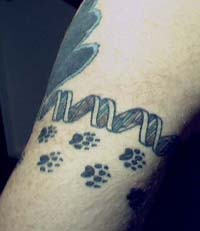 This is my left upper arm. That’s a strand of DNA there in the middle. No, the base pairs don’t correspond with anything; the only base pair sequence I could scrounge up at the time was for E. coli, and I didn’t think that was appropriate. *grin* This one was done in 1996 by the same artist as the first two. It took three sessions, mainly to work around the artist’s schedule- by this time, tattooing had become quite popular in Athens, and there weren’t any reputable shops to take up the excess. The first session, 2 hours, got the outlines done; the next, one hour, got the small bit of color done; and the last, one hour, finished up the solid black and the shading.
This is my left upper arm. That’s a strand of DNA there in the middle. No, the base pairs don’t correspond with anything; the only base pair sequence I could scrounge up at the time was for E. coli, and I didn’t think that was appropriate. *grin* This one was done in 1996 by the same artist as the first two. It took three sessions, mainly to work around the artist’s schedule- by this time, tattooing had become quite popular in Athens, and there weren’t any reputable shops to take up the excess. The first session, 2 hours, got the outlines done; the next, one hour, got the small bit of color done; and the last, one hour, finished up the solid black and the shading.
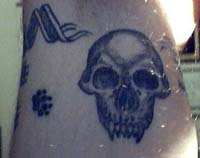 This last picture on the right here is of my armpit. Savic, the artist who’s done all of my tats so far, explained that making a regularly repeating geometric shape- like the DNA strand- join up perfectly is next to impossible; so the join is usually hidden in the armpit and just fades out. I thought that was kind of a cop-out; so we sat and thought about what should go there. A werewolf skull popped into my head and neatly meshed with certain ideas, so there it went.
This last picture on the right here is of my armpit. Savic, the artist who’s done all of my tats so far, explained that making a regularly repeating geometric shape- like the DNA strand- join up perfectly is next to impossible; so the join is usually hidden in the armpit and just fades out. I thought that was kind of a cop-out; so we sat and thought about what should go there. A werewolf skull popped into my head and neatly meshed with certain ideas, so there it went.
Note: I’d recommend against getting your armpit tattooed. That hurt like a mother.
In all likelihood, these won’t be my only tattoos, either. I’m not going for the full body-suit or an arm full of ink; my job has dress-code requirements that’ll keep me from getting anything tattooed below shirtsleeve length. I plan on getting something on the right upper arm and on the lower back. My only regret is that I didn’t plan all the pieces out as a unified whole. I’m brainstorming on ways to integrate all of the pieces into one whole.
If you’re planning on getting tattoos, keep some things in mind:
- Yes, they do hurt. There’s no way around that. A reputable artist won’t work on you if you’re drunk or stoned, trying to mask the pain. Think of it this way; this is a permanent part of your body. It should cost something other than money.
- Personally check the shops in your area. Ask to see their portfolios. Select an artist that does the type of artwork you’re planning and does it well. Some specialize in tribal art, some in free-form art, some only do pre-drawn flash art. And some are truly awful.
- While you’re there, ask them about their procedures. They should use fresh ink containers and ink for each customer. Any equipment- guns, needles, etc.- should be autoclaved to ensure sterility. If they scoff at your questions, leave and don’t come back. Do you really want someone else’s blood-borne diseases?
- Put some thought into what you want done. Tattoos aren’t forever anymore, but given the cost- and pain- of tattoo removal procedures, they might as well be. Don’t get stuck with a piece of crap.
- Afterwards, follow the artist’s after-care instructions- usually keeping the piece dry and aired, applying bacitracin or similar ointment to it for the first week or so, and applying a good moisturizing lotion to it for a couple of weeks after that. And, of course, use sunscreen on it… sunlight fades tattoos!
